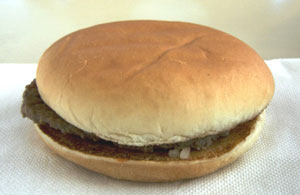UPDATE [10/15/2024]: McDonald’s released a statement in response to the Happy Meal Project. They argue that the burger didn’t rot from lack of moisture: “If food is/or becomes dry enough, it won’t grow mold or bacteria. In fact, any food purchased from a restaurant or grocery store or prepared at home that lacks moisture would also dehydrate and see similar results if left in the same environment.”
We recently posted an article about photographer Sally Davies’ “Happy Meal Project,” which documents the life of a McDonald’s hamburger and fries as they steadfastly refuse to rot. The project is not the first of its kind, and there are reports of burgers that looked about the same after four and even 12 years after their date of purchase. The idea is this: most healthy food will eventually spoil, so how long a food goes without going bad is an indicator of unhealthy ingredients.
So what’s behind the miraculous preservation? As far as the beef patty is concerned, it’s not from preservatives. According to the ingredients list published by McDonald’s, the patty contains 100 percent Angus beef, prepared with a “grill seasoning” that consists of salt (we wonder how much) and black pepper. The high fat content and the high cooking heat are enough to account for the burger’s resistance to decay. Over time, the moisture in the burger will evaporate and the fat will harden, much like it does in arteries of people suffering from atherosclerosis.
The fries and the bun are a different story. A regular bun contains the following:
“Enriched flour (bleached wheat flour, malted barley flour, niacin, reduced iron, thiamin mononitrate, riboflavin, folic acid, enzymes), water, high fructose corn syrup, sugar, yeast, soybean oil and/or partially hydrogenated soybean oil, contains 2% or less of the following: salt, calcium sulfate, calcium carbonate, wheat gluten, ammonium sulfate, ammonium chloride, dough conditioners (sodium stearoyl lactylate, datem, ascorbic acid, mono- and diglycerides, ethoxylated monoglycerides, monocalcium phosphate, enzymes, guar gum, calcium peroxide, soy flour), calcium propionate and sodium propionate (preservatives), soy lecithin.”
As many others have quipped, this is food you need a chemistry degree to understand, much less make. As you can see, the bread contains calcium propionate and sodium propionate as preservatives, in addition to sugar and salt, which are also preservatives.
We’ll spare you the list of oily ingredients used to make the french fries, but suffice it to say that they use citric acid as a preservative, and require chemicals to “maintain color” and antifoaming agent. Plus, the fries are coated in salt, one of nature’s original preservatives–although little else is natural.
So here’s the long and short of it: not only are these foods full of chemicals, they’re also full of unhealthy fats and sodium, which we knew all along.
Also Read:

